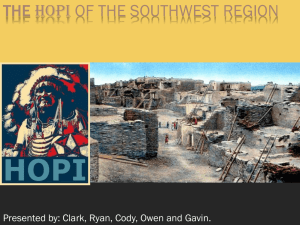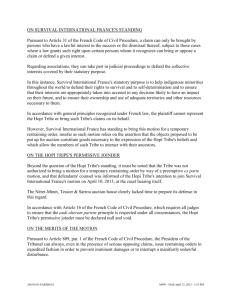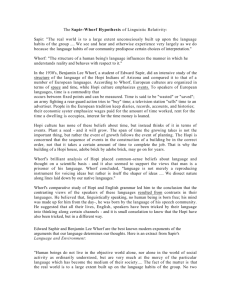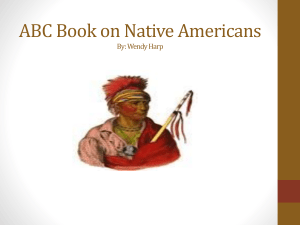Hopi Ancestral Sites and Cultural Landscapes
advertisement
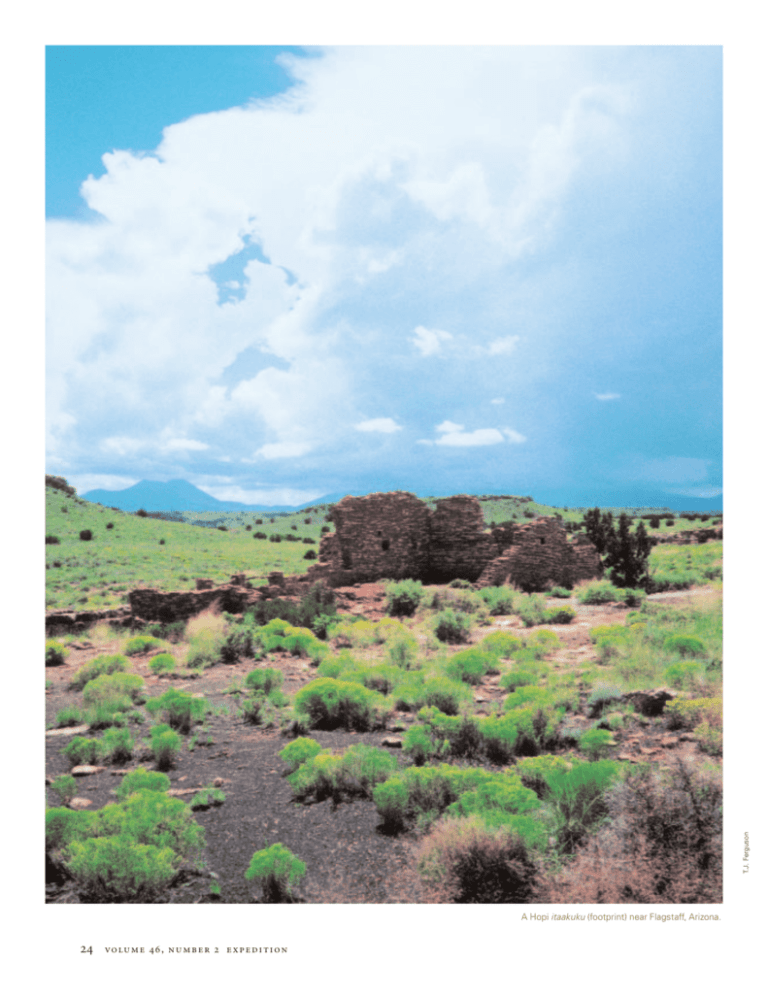
T.J. Ferguson A Hopi itaakuku (footprint) near Flagstaff, Arizona. , Hopi Ancestral Sites and Cultural Landscapes . . . — —encompasses H everywhere the Hopi people and their ancestors traveled, lived, and were buried during the long migration from the place of origin to Tuuwanasavi (earth center) on the Hopi Mesas. As a cultural landscape, Hopitutskwa is defined by landforms associated with deities and historical events, rivers, springs, trails, shrines, and what the Hopi people call itaakuku or “our footprints.” . . . ⁄ ANG KUKTOTA When the Hopi climbed out of the Sípàapuni (place of emergence) into the Fourth Way of Life, they entered into a spiritual covenant with the deity Maasaw to migrate until they reached their destiny at Tuuwanasavi. Ang kuktota, literally, “along there, make footprints,” was one of the instructions given to the Hopi to demonstrate they had fulfilled their spiritual obligations. “Footprints” include the ruins of former settlements, and the pottery, stone tools, petroglyphs, and other artifacts left behind as offerings. For the Hopi people, these footprints are monuments that provide proof of ancestral migration and land stewardship. ARCHAEOLOGICAL SITES AND CULTURAL LANDSCAPES: PLACE, SCALE, TIME, AND CONTEXT Kiikiqö (archaeological sites) occupy a geographical space that can be physically bounded by architecture, artifact scatters, and other features. In Hopi thought, however, these sites are inextricably associated with the surrounding region. The culturally meaningful scale for interpreting itaakuku (footprints) far exceeds the Hopi petroglyphs at Tutuveni, a shrine on the Salt Pilgrimage to the Grand Canyon. , T.J. Ferguson with assistance from the Hopi Land Information System Office (above), T.J. Ferguson (left) Cultural landscape of Nuvatukya’ovi (San Francisco Peaks). boundaries of archaeological sites as delineated by artifact scatters and architecture. As elements of the cultural landscape, sites need to be interpreted in a regional scale. For example, the Hopi Tribe recently collaborated on a project to study Hopi history at forty archaeological sites impacted by construction of a highway near Flagstaff, Arizona, lying northeast of the San Francisco Peaks, in an area overlooking the Little Colorado River Valley. Hopi cultural advisors placed these archaeological sites in a broad context, with Nuvatukya’ovi (San Francisco Peaks) and the ancestral site of Wupatki anchoring the western end of a cultural landscape that extended to the Hopi Mesas, 65 miles to the east. The small sites within the U.S. 89 highway corridor could only be understood in relation to the sweeping routes of clan migrations, Hopi deities associated with Sunset Crater and mountain peaks, and the trails used during religious pilgrimages to the San Francisco Peaks. This region constitutes Pasiwvi, a place name derived from the Hopi words pasiwni (intent, plan, design) and pasiwta (be finished, completed). Pasiwvi, sometimes translated as the “meeting place” or “the place of making decision,” simultaneously signifies a specific pueblo, a geographical region, and an T.J. Ferguson epoch. As a place name, Pasiwvi is applied to Elden Pueblo but it also applies to the region surrounding the mountain peaks of Nuvatukya’ovi, where Hopi clans came together to deliberate over spiritual instructions. Pasiwvi is thus a place of great thought, where Hopi ancestors met and contemplated their spiritual covenant with the deity Maasaw to leave their footprints on the land and serve as earth stewards. After clans migrated from Pasiwvi to the Hopi Mesas, Hopi people traveled back to the area to make religious offerings at shrines. The trails used during these pilgrimages provide a physical connection between Nuvatukya’ovi and the Hopi villages, and their use provides an opportunity for new generations of Hopi people to experience Hopi history. Petroglyphs are one of the most important aspects of the archaeological record that Hopi people use to define cultural landscapes. This is because petroglyphs embody iconographic elements that mark the occupation of land by specific clans. The Hopi inscription of clan symbols is well documented at Tutuveni, one of a series of shrines located along the Salt Pilgrimage trail to the Grand Canyon. The Hopi people interpret the clan symbols, hand prints, and ritual figures as visual and tactile signs intentionally made to connect descendents with their ancestors. Time is implicated in archaeological sites because they represent a series of places occupied by ancestors in an earlier era, a period between emergence and the establishment of the Sidney Sahneyah visits Tonto Cliff Dwellings at Wukoskyavi. . . . ⁄ Ang kuktota – spiritual instruction, “along there, make footprints” Hopitutskwa – Hopi land Itaakuku – “footprints,” the physical evidence of past occupation Kiikiqö – ancestral villages (archaeological sites) Maasaw – deity who owns the Fourth World Navoti – historical understanding handed down by ancestors Nuvatukya’ovi – San Francisco Peaks in Arizona Palatkwapi – “Red Land of the South” Pasiwvi – “place of instruction,” region around Flagstaff, Arizona Tutuveni – “writing on rocks,” shrine on pilgrimage to Grand Canyon Tuuwanasavi – Earth Center on Hopi Mesas Wiimi – sacred artifacts and knowledge about their use Wukoskyavi – “big valley,” Tonto Basin in Arizona Hopi villages. While Hopi people appreciate and make use of chronological data provided by scientific archaeology, Hopi theories of the past involve a spatial geography recounted in traditional clan histories, and this is more important than time as an absolute, linear scale. The location of archaeological sites carries meaning in relation to accounts that describe the directions various clans traveled as they set their footprints on the land, and this directionalism is associated with a relative temporal sequence that lead to the founding of the Hopi villages. The Tonto Cliff Dwellings in central Arizona, for instance, were occupied by Hopi clans during their journey from Palatkwapi (the “Red Land of the South”) to the Hopi Mesas. The spatial placement of Wukoskyavi (Tonto Basin) between Mesoamerica and Hopi is as important in Hopi concepts of the past as the absolute dating of the site by archaeologists to the 14th century. Ancestral villages that have fallen into ruin are not dead places whose only meaning comes from scientific values. The Hopi ancestors who lived in these villages still spiritually occupy these places, and these ancestors play an integral role in the contemporary Hopi ceremonies that bring rain, fertility, and other blessings for the Hopi people and their neighbors throughout the world. Itaakuku—footprints—are thus part of the living legacy of the ancestors, and they play a vital role in the religious activities essential to the perpetuation of Hopi , society. Shrines are places where ritual deposits are made, and because their ancestors and sacred objects were buried in ancestral villages, the Hopi people care for these places as shrines. Hopi people visiting an ancestral village feel a deep reverence for both the place and the surrounding landscape. NAVOTI AND WIIMI: ARCHAEOLOGICAL SITES, CULTURAL LANDSCAPES, AND THE PHENOMENOLOGY OF HOPI HISTORY Much Hopi history is apprehended subjectively through the personal experience of archaeological sites and cultural landscapes. At a personal level, many Hopi people transcend the factual knowledge and assumptions derived from scientific archaeology in a pure intuition of history derived from spiritual purpose, intention, and respect for ancestors. This experience is tempered by an individual’s understanding of navoti and wiimi. Navoti is a historical understanding handed down by ancestors to their descendants. Wiimi includes sacred artifacts and the knowledge of how to use them properly in religious ceremonies and rituals. Wiimi is an essential part of the archaeological record, having been ritually deposited by Hopi ancestors engaged in religious activities in the ancient past. T.J. Ferguson (above left), Michael Yeatts, courtesy of Hopi Cultural Preservation Office (above right) Ronald Humeyestewa discusses navoti and wiimi with fellow tribal members at an ancestral village he excavated during the U.S. 89 Project. Leigh J. Kuwanwisiwma and T. J. Ferguson conducting research at Powell’s Cave in the Little Colorado River Gorge during a river trip through the Grand Canyon in 1993. Together, navoti and wiimi provide both the means to know the past and the ability to invoke the power of the ancestors in the present through ritual offerings and ceremonies. The propitiation of ancestors through prayers based on navoti and wiimi is key to maintaining Hopi culture and life. In Hopi thought, the meaning of the past is what it contributes to life in the present. The historical association with Hopi ancestors is reinforced when Hopi people discover ritual artifacts in the archaeological record that are identical to wiimi still in use in Hopi ceremonies. The abiding connection Hopi people have with the material culture of their ancestors gives archaeology a deeply personal, as well as intellectual, meaning. Archaeology thus helps give focus to the comprehension of ancestral lifeways embodied in the monuments that comprise Hopi footprints on the landscape. United States for 25 years studying indigenous land use and the ways that archaeological sites are used in the retention and transmission of contemporary Native American culture. . is a member of the Tepngyam (Greasewood Clan) from the village of Paaqavi on Third Mesa, Hopi Indian Reservation. He has served as the Director of the Hopi Tribe’s Cultural Preservation Office for 15 years. In this capacity, he directs a wide range of programs oriented toward language retention and the preservation of heritage sites. For Further Reading Colton, Mary Russell F., and Harold S. Colton. “Petroglyphs, The Record of a Great Adventure.” American Anthropologist 33-1 (1931):32-37. Dongoske, Kurt, Leigh Jenkins, and T. J. Ferguson. “Understanding the Past through Hopi Oral History.” Native Peoples 6-2 (1993):24-31. Elson, Mark D., and Michael H. Ort. “In the Shadow of the Volcano, Recent Research at Sunset Crater.” Archaeology Southwest 17-1 (2003). Ferguson, T. J., and Roger Anyon. “Hopi and Zuni Cultural Landscapes: Implications of History and Scale for Cultural Resources Management.” In Native Peoples of the Southwest: Negotiating Land, Water, and Ethnicities, edited by Laurie Weinstein, pp. 99-122. Westport, CT: Bergin & Garvey, 2001. Kuwanwisiwma, Leigh. “Hopit Navotiat, Hopi Knowledge of History: Hopi Presence on Black Mesa.” In Prehistoric Culture Change on the Colorado Plateau: Ten Thousand Years on Black Mesa, edited by Shirley Powell and Francis E. Smiley, pp. 161-63. Tucson, AZ: University of Arizona Press, 2002. . . is the sole proprietor of Anthropological Research, LLC, a research company in Tucson, Arizona, where he also is an Adjunct Professor of Anthropology at the University of Arizona. He has worked in the Southwestern . . . ⁄

